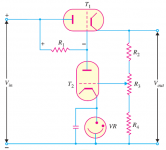Is there any reason that a 12AU7 series regulator would not be appropriate for power pentode screen supply? 20mA plate current would seem adequate for a pair of medium power pentode screens and if voltage drop across the pass tube is not huge 2.75 watt dissipation seems OK. Am I missing anything?
mike
mike
did you elevate the filament to within 100volt of the cathode ? ( yes i know that philips says 180 volt )Is there any reason that a 12AU7 series regulator would not be appropriate for power pentode screen supply? 20mA plate current would seem adequate for a pair of medium power pentode screens and if voltage drop across the pass tube is not huge 2.75 watt dissipation seems OK. Am I missing anything?
mike
It depends on several things. Some power pentodes have high ratio of plate/screen current (like 807), but most have lower ratio, and the latter may draw screen current as high as 25% of plate current at maximum power in Class AB. Worth examining data sheets to see the required screen current capability with your specific pentode and your settings.
Screen current is generally lower at high ratios of plate/screen voltages, but many classical circuits use Ua=Ug2 for simplicity and maximum power.
Although 20 mA is rated plate current of 12AU7, I wouldn't design for more than 10 mA/section.
Screen current is generally lower at high ratios of plate/screen voltages, but many classical circuits use Ua=Ug2 for simplicity and maximum power.
Although 20 mA is rated plate current of 12AU7, I wouldn't design for more than 10 mA/section.
Last edited:
how much voltage dropped in the regulator? What voltage do you wish to supply, and how much sag is acceptable? A few kilohms of output impedance may be an issue for large swings unless you do a feedback arrangement so that the 12AU7 output voltage stays regular.
Personally I would prefer an IRF820 with a voltage reference of some sort for this job.
Personally I would prefer an IRF820 with a voltage reference of some sort for this job.
did you elevate the filament to within 100volt of the cathode ? ( yes i know that philips says 180 volt )
I haven't actually done a design. I am just getting some input as to the feasibility. I have a ton of AU7s on hand so if the idea isn't totally stupid it seemed like a fun exercise. I assumed that a raised heater supply would be necessary.
I am thinking primarily in terms of something in the EL84 class primarily. The biggest bottle I would even be considering is a 6LU8. Probably a push pull monoblock.
the 6EW7, 6FD7, 6FR7 dissimilar triodes would be better as regulators imho...https://www.amplifiedparts.com/sites/default/files/associated_files/6fd7.pdf
http://electronbin.com/sheets/049/6/6DR7.pdf
http://electronbin.com/sheets/049/6/6EW7.pdf
http://electronbin.com/sheets/049/6/6DR7.pdf
http://electronbin.com/sheets/049/6/6EW7.pdf
So are the types like 6DN7. 6CM7 comes to mind, and the ones with a higher gain error amp like 6EM7 come to mind.
I have gotten quite good results with just a MOSFET hanging from a voltage divider, and source to ground resistor to up the current a bit and increase the zero-demand gm of the device. The delivered gm can be huge compared to tubes, and the bigger the heatsink, the more current( and therrefore gm ) can be had...
Don't forget to clamp the n-channel's gate with a good zener. BZX55C16 works quite well IMO. By the time you have a bit more than 5V positive to the source, a FQP1N60 can flow a whole mess of current. FQP2N90 is a 900V option with only a wee bit more gate capacitance.
cheers,
Douglas
I have gotten quite good results with just a MOSFET hanging from a voltage divider, and source to ground resistor to up the current a bit and increase the zero-demand gm of the device. The delivered gm can be huge compared to tubes, and the bigger the heatsink, the more current( and therrefore gm ) can be had...
Don't forget to clamp the n-channel's gate with a good zener. BZX55C16 works quite well IMO. By the time you have a bit more than 5V positive to the source, a FQP1N60 can flow a whole mess of current. FQP2N90 is a 900V option with only a wee bit more gate capacitance.
cheers,
Douglas
I have amosfet too, stabilized from CCS = LND150 and a resistor; adjusting the current with a pot on the source of the lnd allows me to quickly change the voltage. It works great. You can do the same witha ECC82 too. Of course that works great too.
Is there any reason that a 12AU7 series regulator would not be appropriate for power pentode screen supply? 20mA plate current would seem adequate for a pair of medium power pentode screens
if you have ever seen the frightening G2 currents developed with a lot of pentodes you wouldn't dream of such a thing.
It's why GEC specifically developed triodes and "triode strapped pentodes" for precisely this sort of service - read peak currents of 120m/a and Pa of 15W
regulators have to be very tough and not blow up easy.
Ask me how I know. I've blown up load of the things!
Thank you, just the kind of input I was looking for.
if you have ever seen the frightening G2 currents developed with a lot of pentodes you wouldn't dream of such a thing.
It's why GEC specifically developed triodes and "triode strapped pentodes" for precisely this sort of service - read peak currents of 120m/a and Pa of 15W
regulators have to be very tough and not blow up easy.
Ask me how I know. I've blown up load of the things!
- Home
- Amplifiers
- Tubes / Valves
- 12AU7 screen regulator OK?
